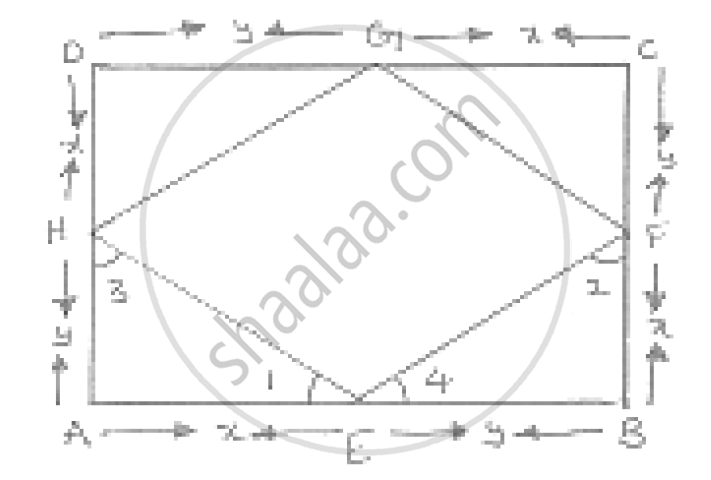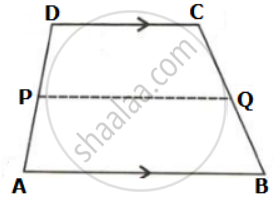Advertisements
Advertisements
प्रश्न
ABCD is a square E, F, G and H are points on AB, BC, CD and DA respectively, such that AE = BF = CG = DH. Prove that EFGH is a square.
उत्तर १

We have
AE = BF = CG = DH = x (say)
∴ BE = CF = DG = AH = y (say)
In Δ ' s AEH and BEF , we have
AE = BF
`∠`A = `∠`B
And AH = BE
So, by SAS configuration criterion, we have
ΔAEH ≅ ΔBFE
⇒ `∠`1 = `∠`2 and `∠`3 = `∠`4
But `∠`1+ `∠`3 = 90° and `∠`2 + `∠`4 = 90°
⇒ `∠`1+ `∠`3+ `∠`2 + `∠`4 = 90° + 90°
⇒ `∠`1+ `∠`4 + `∠`1+ `∠`4 = 180°
⇒ 2 (`∠`1+ `∠`4) = 180°
⇒ `∠`1+ `∠`4 = 90°
HEF = 90°
Similarly we have `∠`F = `∠`G = `∠`H = 90°
Hence, EFGH is a square
उत्तर २

We have
AE = BF = CG = DH = x (say)
∴ BE = CF = DG = AH = y (say)
In Δ ' s AEH and BEF , we have
AE = BF
`∠`A = `∠`B
And AH = BE
So, by SAS configuration criterion, we have
ΔAEH ≅ ΔBFE
⇒ `∠`1 = `∠`2 and `∠`3 = `∠`4
But `∠`1+ `∠`3 = 90° and `∠`2 + `∠`4 = 90°
⇒ `∠`1+ `∠`3+ `∠`2 + `∠`4 = 90° + 90°
⇒ `∠`1+ `∠`4 + `∠`1+ `∠`4 = 180°
⇒ 2 (`∠`1+ `∠`4) = 180°
⇒ `∠`1+ `∠`4 = 90°
HEF = 90°
Similarly we have `∠`F = `∠`G = `∠`H = 90°
Hence, EFGH is a square
APPEARS IN
संबंधित प्रश्न
ABC is a triangle right angled at C. A line through the mid-point M of hypotenuse AB and parallel to BC intersects AC at D. Show that
- D is the mid-point of AC
- MD ⊥ AC
- CM = MA = `1/2AB`
ABCD is a rhombus, EABF is a straight line such that EA = AB = BF. Prove that ED and FC when produced meet at right angles
Fill in the blank to make the following statement correct
The triangle formed by joining the mid-points of the sides of an isosceles triangle is
In triangle ABC, M is mid-point of AB and a straight line through M and parallel to BC cuts AC in N. Find the lengths of AN and MN if Bc = 7 cm and Ac = 5 cm.
A parallelogram ABCD has P the mid-point of Dc and Q a point of Ac such that
CQ = `[1]/[4]`AC. PQ produced meets BC at R.

Prove that
(i)R is the midpoint of BC
(ii) PR = `[1]/[2]` DB
In parallelogram ABCD, P is the mid-point of DC. Q is a point on AC such that CQ = `(1)/(4)"AC"`. PQ produced meets BC at R. Prove that
(i) R is the mid-point of BC, and
(ii) PR = `(1)/(2)"DB"`.
In the given figure, ABCD is a trapezium. P and Q are the midpoints of non-parallel side AD and BC respectively. Find: AB, if DC = 8 cm and PQ = 9.5 cm
In ΔABC, X is the mid-point of AB, and Y is the mid-point of AC. BY and CX are produced and meet the straight line through A parallel to BC at P and Q respectively. Prove AP = AQ.
In ΔABC, D and E are the midpoints of the sides AB and AC respectively. F is any point on the side BC. If DE intersects AF at P show that DP = PE.
Prove that the line joining the mid-points of the diagonals of a trapezium is parallel to the parallel sides of the trapezium.
